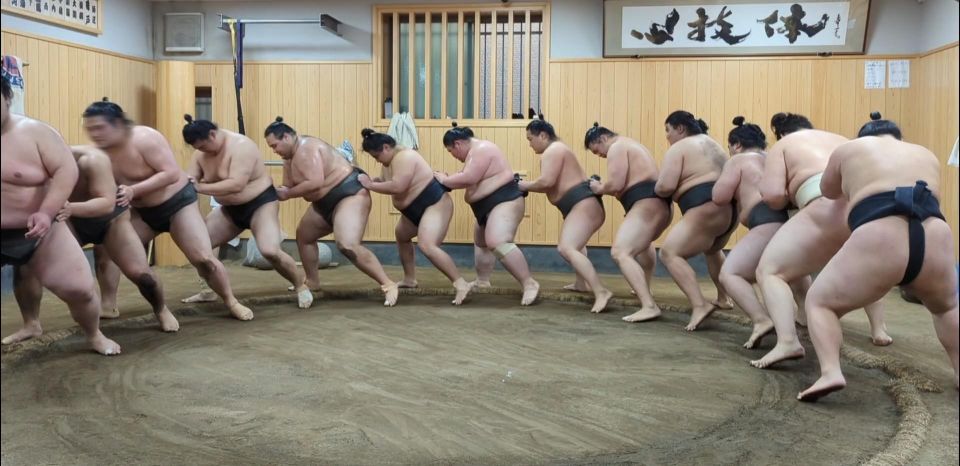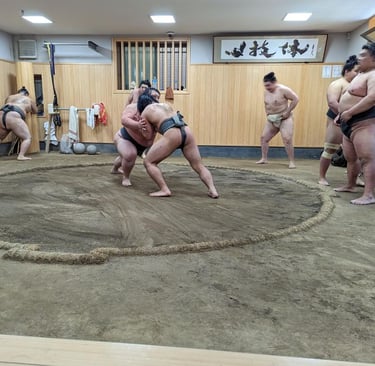The Unknown Facts of Sumo: A Deep Dive into an Ancient Tradition
Sumo is not just a test of strength and skill; it is also a spiritual endeavor. The sport is deeply intertwined with Shinto beliefs, and wrestlers perform various rituals to honor the gods. From the initial stomp to drive evil spirits from the ground to the clapping of hands to attract the gods' attention, each act is symbolic and spiritually significant.
Ashley On The Map
9/30/20234 min read


The Unknown Facts of Sumo: A Deep Dive into an Ancient Tradition
Today, I found myself on a train from Zushi, a quaint beach town, to Sumida City in Tokyo. My mission? To witness the ancient art of Sumo wrestling up close. Sumo wrestling, a sport deeply embedded in Japanese culture, is often misunderstood by those outside of Japan. While many are familiar with the spectacle of large men pushing each other out of a ring, there are numerous unknown facts about this ancient art form that make it a fascinating subject of study. As the train pulled into Tokyo, I felt a sense of anticipation. This was going to be a day of learning and spiritual growth.
Origins in Agricultural Rituals
I arrived in Sumida City and was immediately struck by the contrast. Zushi's laid-back beach vibe was replaced by the bustling energy of Tokyo. Skyscrapers reached for the heavens, and people from all walks of life scurried about, each engrossed in their own world. But amidst this modernity, I was here to experience something ancient and deeply rooted in Japanese culture. One of the lesser-known facts about Sumo is its ancient origins as an agricultural ritual. Dating back over 2,000 years, Sumo was initially a form of religious practice aimed at praying for a bountiful harvest. Wrestlers would perform in front of shrines, and the outcome of the match was believed to predict the success of the year's crop. This historical context adds a layer of depth to Sumo, elevating it from mere sport to a ritualistic tradition. I walked to the Sumo training facility, my heart pounding with excitement. As I entered, a wave of heat and the earthy smell of sweat hit me. The atmosphere was electric.
The Sacred Dohyo
Massive Sumo wrestlers were engaged in intense practice, their bodies colliding with a force that seemed to shake the very ground. I took a seat quietly, not wanting to disturb the sanctity of the space. The Sumo ring, known as the "dohyo," is another aspect shrouded in mystery. Contrary to popular belief, the dohyo is not just a platform for wrestling; it is a sacred space. The clay surface is ritually purified with salt before each match, and a new dohyo is constructed for each tournament. The practice was a blend of physical prowess and spiritual ritual. Before each bout, the wrestlers would perform a series of Shinto rituals, purifying the ring with salt and invoking the blessings of the gods. It was a fascinating blend of the physical and the spiritual, a testament to the depth of Japanese culture. The sanctity of the dohyo is so important that women, considered impure in traditional Shinto beliefs, are not allowed to enter it. As a woman, my presence was a solid testament of how the modern world has transformed many traditional practices.
The Role of Salt in Purification
The act of throwing salt into the ring before a match is not merely for show; it serves a deeper purpose. Salt is considered a purifying substance in Shintoism, and its scattering is believed to ward off evil spirits and cleanse the area. This ritualistic act adds a spiritual dimension to Sumo, making each match a sacred event. As I watched, one of the wrestlers caught my eye. He was younger than the others, but his technique was impeccable. Each move was executed with a grace that belied his massive size.
Spirituality and Shinto Beliefs
After the practice, I had a chance to speak with him. His name was Hiroshi, and he had been practicing Sumo since he was a child.
"We believe that Sumo is not just a sport," he told me, "It's a way of life. It teaches us discipline, respect, and the importance of spiritual purity." Sumo is not just a test of strength and skill; it is also a spiritual endeavor. The sport is deeply intertwined with Shinto beliefs, and wrestlers perform various rituals to honor the gods. From the initial stomp to drive evil spirits from the ground to the clapping of hands to attract the gods' attention, each act is symbolic and spiritually significant.
The Specialized Sumo Diet
It was finally time for lunch, which made me think of how the way of life required strategic eating. The Sumo diet is a highly specialized regimen designed to maintain the wrestler's massive size while providing the necessary nutrients for peak performance. The primary meal is "Chanko-nabe," a protein-rich stew made with fish, meat, and vegetables. Contrary to popular belief, Sumo wrestlers do not eat recklessly; their diet is calculated to provide the optimal balance of nutrients. I left the training facility with a sense of awe and a newfound respect for this ancient art form. As I made my way back to the train station, my mind was buzzing with thoughts. I was already planning my next adventure, eager to explore more of what this incredible country had to offer.
As the train pulled out of Sumida City, I looked out of the window at the sprawling metropolis fading into the distance. I felt grateful for this journey, for the opportunity to grow and learn. And as the train sped back towards Zushi, I realized that sometimes the most profound lessons come when you venture into the unknown. The world of Sumo wrestling is a rich tapestry of history, spirituality, and athleticism. These lesser-known facts offer a glimpse into the depth and complexity of this ancient art form, making it a subject worthy of deeper exploration. Sumo is not just a sport; it is a living tradition that embodies the cultural and spiritual heritage of Japan. And so, I look forward to my next adventure. Japan has much to offer, and I am eager to explore it all.




